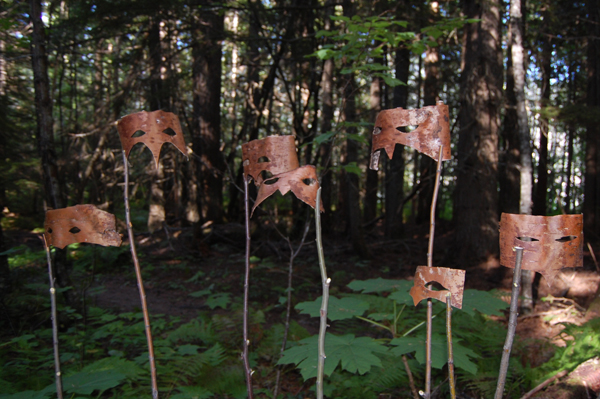
By David F. Rooney
We may live in one of Canada’s most magnificent landscapes, but the creation of what is recognized as “environmental art” is still something of a novelty here.
This year 15 local artists, myself included, were privileged to be accepted to participate in an environmental art project initiated by Parks BC to mark its centenary. The provincial agency put up the cash that allowed us to explore a provincial park — in this case, Blanket Creek — and create pieces of true environmental art.
Each work was produced using locally available natural materials. They were then photographed and the individual works allowed to fall to the ground and decay.
Each artist then selected one image that was then printed on canvas. Those 15 works are the subject of one of the two exhibitions that open at the Revelstoke Visual Arts Centre this Friday at 6 pm.
This was an immensely enjoyable project that taught us a lot about the connections between the land the art we are each capable of creating. To highlight that, local artists Sandra Flood, Eve Fisher, Carmen Segger and Gillian Redwood that consented to comment briefly on what they created… and what they learned. Enjoy!
***
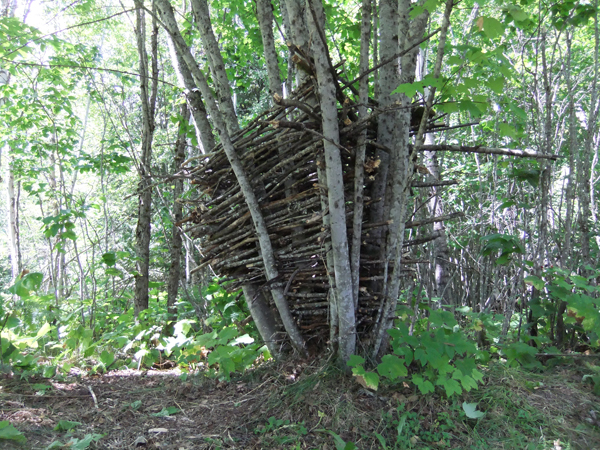
By Sandra Flood
The first reconnoiter to Blanket Creek stimulated all sorts of ideas, thinking about them when I got home I realized that I wanted to make something three-dimensional. A second visit gave me a firm idea when I saw a broken branch suspended between the multiple trunks of a tree. I decided to use the trunks of a tree as the spokes of a basket and weave dead branches through them to make a container.
I selected my tree. There were dead branches strewn everywhere. I set to work. After a short morning’s work my ‘basket’ was barely a meter high and offered little of interest to my camera. Another longer morning’s work built the ‘basket’ to almost two meters.
The day was hot, the bugs loved me and managed to get through my bug jacket which constantly entangled in branches. I tried to eat some lunch without taking off my bug jacket. I sang occasionally to frighten off any bears. A total of two groups of people went past. I started to take photographs. How to capture this three-dimensional structure of twigs woven through multiple trunks defeated me. What I saw and what the camera saw seemed to be two different things. I lay on the ground and photographed. I walked around the ‘basket’ and tried to photograph, other trees got in the way, leaves got in the way, my hands got steadily more itchy with bites. What the camera said was simply not what I saw. Should I come back on another occasion with a ladder and try shooting down into the basket? I retreated, hot and bothered, leaving the ‘basket’ standing among greenery, ghost flowers and silence.
Does the Tree Basket have any deep significance? Nothing beyond the eternal human delight in manipulating materials and leaving a mark of her presence on the landscape.
***
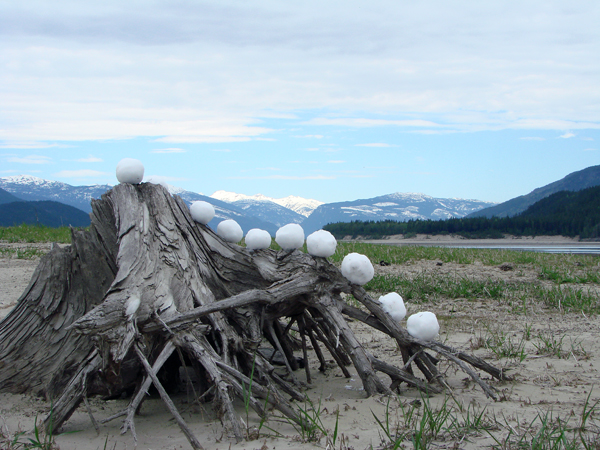
By Carmen Segger
How do you observe and interact with nature, considering it is BC Parks 100th anniversary celebration?
Going out in May I played with different materials and tools: dandelions, snow, a stick which I scribed designs into the damp sand with, made ever increasing circles in dry sand with a large fan rake, and saw what the wind did to the sand around objects.
Upon returning about a month later I received a bit of schooling from Mother Nature, the water level was way up, no sand in sight back to the… idea board. Sure had to let go of the possibilities from before. What I noticed is that it felt great to be outside just playing, both with natural materials and photography. I did have a lingering idea from making snow balls. So, when the cottonwood fuzz was everywhere I went collecting, much warmer, surprisingly it almost packed like snow. I photographed it a lot!
Moving on to other ideas next time I kept more to dry land, making a cocoon-like object out of a pine cone and fuzz. I placed it in all sorts of spots and captured it digitally.
***
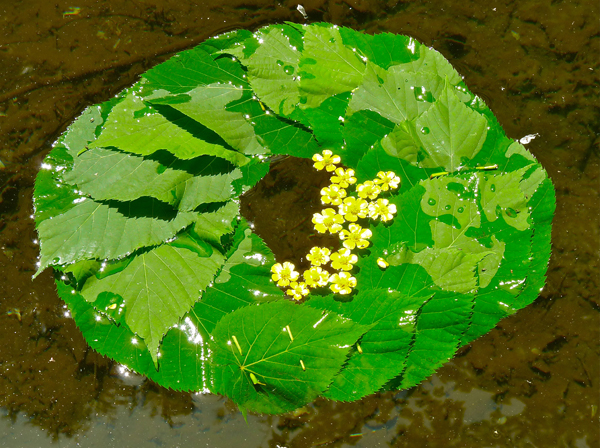
By Eve Fisher
A walk through Blanket Creek Provincial Park in mid June offered a variety of materials and locations, from which I could choose, for my art project. The grasses and driftwood of the shoreline; the red cedar stumps and blue grey lichens or the large devilʼs club leaves and delicate Queens cup of the Nature Trail; the lush green moss covered rocks of the Sutherland Falls area were all possibilities I could choose to explore further.
However, I was drawn particularly to the area of the Domke cabin – and its large elm trees and the small overgrown swimming pool. Inspired by Environmental Artist Andy Goldsworthyʼs creations with leaves I would construct a garland of the large spring green elm leaves – using leaves descending in size and joined only by the strong stems of those leaves. I would toss the garland on the pool, adding a few yellow buttercup heads at the centre for accent. As a background, I would use the varied patterns of the water seeping onto the leaves and also the reflection of the blue sky and clouds in the water. I took several shots of this arrangement, looking straight down onto it. Choosing the best image was the final stage.
This was a most enjoyable and rewarding project.
Jackie Pendergast had the much more challenging task of coordinating the project and arranging for the group’s photos to be printed on canvas . Thank you Jackie.
***
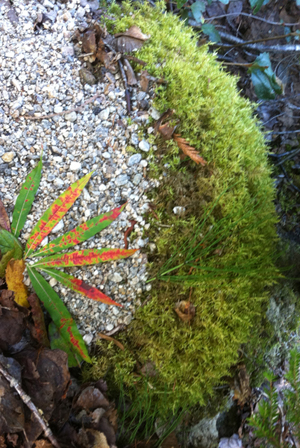
By Gillian Redwood
Environmental Art is something that has fascinated me since I saw my first Andy Goldsworthy work in the late 1970s. His creations are some of the most beautiful things I have seen, as good and sometimes better than Nature itself. So seeing the whole movie of his work at the Revelstoke Public Art Gallery at the start of this project, I was mesmerized….. how could it look so serene and so simple? I was fired with enthusiastic creative energy.
The reality and challenges first hit me when I arrived back at the end of a successful day in the Park with about 100 images from all different angles of my project. All of them, without exception, had the central theme out of focus, and some blade of grass or broken stump at the side… beautifully clear. I realized at that moment that an environmental artist must first be an adequate or even better, an exceptional photographer, to really make the most of her art.
Another day, mosquitoes, dullish weather, a certain pressure of completion, and a delight in the mossy environment beside the lake — I completed a new and very different creation. By moving gravel and making the most of the newly coloured leaves of early Fall, and with the benefit of my daughter Montana’s iPhone camera, we made the final image.



